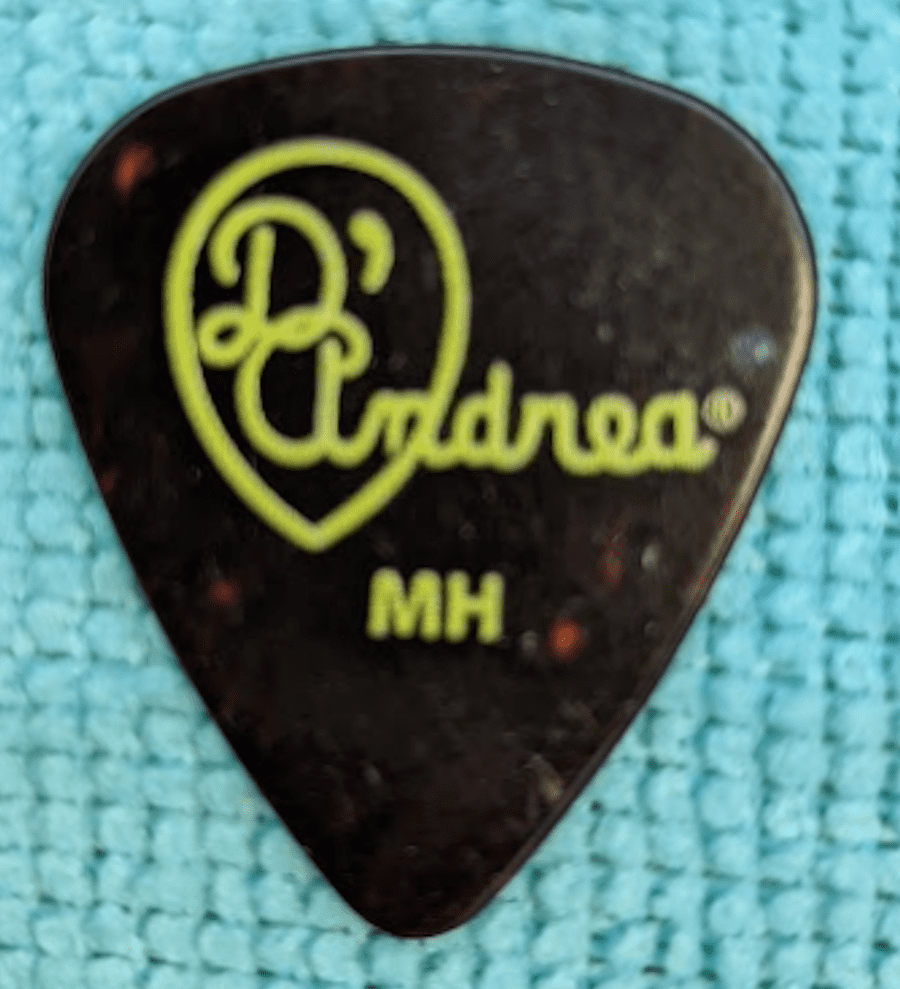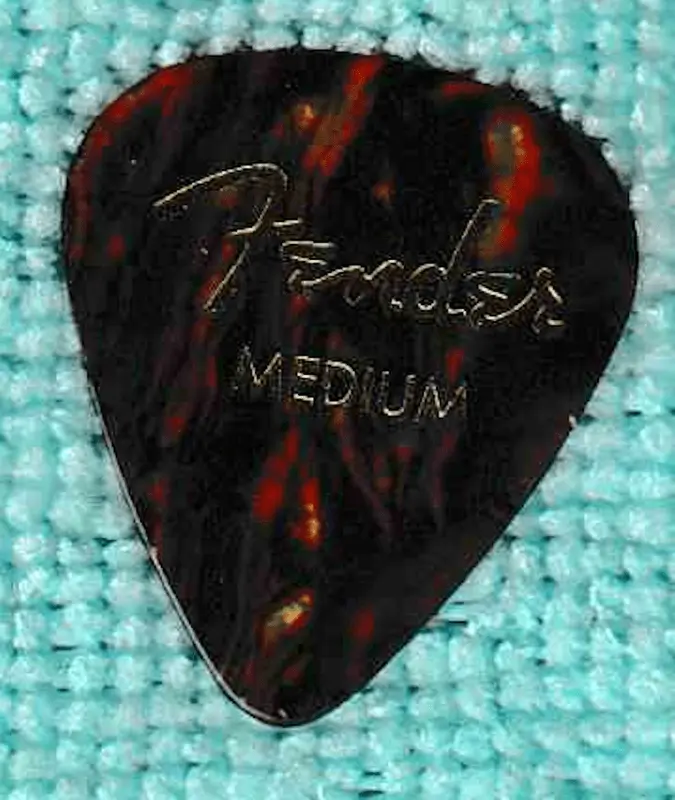Have you found that you like a certain shape of pick, or you are searching for a certain type and have no idea how to describe it in order to search for it? So did I! Let’s first look at the D’Andrea #351 Pick Shape:
Here is an outline of a standard of the industry’s most used pick shape. It is the D’Andrea #351 Pick Shape that all of us know:

Where it all got started:
Did you know that companies such as Fender (and D’Andrea originally) have a numerical system not just for their guitar gear, but for their picks also? Some shapes have been lost to history, and so also with their numbers. The idea behind talking about shape numbers is that knowing this detail can help you shop and identify products. Besides that, it’s interesting..
Decades ago, when Celluloid picks were first made and D’Andrea was THE company making them, they had dies or forms that were numbered. Each number was a particular shape. The shape above that we all know was numbered 351. It was the D’Andrea #351 Pick Shape.
While the earliest picks recorded where feather quils and sticks, back before the roaring 20’s Celluloid was invented, and many shapes were invented for picks, after many other household items started being made. The #351 D’Andrea Pick Shape, of all the shapes that were made, has survived the test of time.
To this day, it’s the most popular shape, at least by sales. But it doesn’t work for everyone.
Here is the classic 351 shape that most people think of in their head when they think “pick”.

Premiere Guitar’s History Site says that:
“Luigi D’Andrea, as the result of a big mental leap seeing that the only plastic of the time, Celluloid (from Camphor and Nitrocellulose, the stuff early movie film and clothing and combs were made of). He saw a shop selling some celluloid sheets and other items and made them into picks, which quickly became a big business.”
And they continue:
“It was the birth of the 351, Luigi’s name for our most common pick shape. Shopping on the Fender site you will see many versions of the 351 for sale. Dozens and dozens of makers produce that shape.”
No need for Tortoise Shell for picks now!
Before this, Tortoise Shells were used (a no-no today, the hawksbill tortoise is still endangered and struggles to beat the odds, they live a hard life). Also, there really is no need for tortoiseshell as there are Casein Picks and others that are approximations.
In the History section, we will delve into the pick’s history more. That is still coming to the site.
The Fender Store has various D’Andrea sizes, most of them. So does D’Andrea themselves! If you want the original or want to see what it all started from, D’Adrea is the original. Try some of their picks.
The shape itself, what is it?
This Pick, measured from rear to front as we look at it in the normal profile is 1 and 10/64ths” with a shoulder of 1 and 2/64ths”. Or in mm: 30.4 x 26 wide.
It is a “flat pick” The D’Andrea #351 Pick Shape comes to use from a flat sheet with no perforations and only labeling. It does come in thicknesses ranging from very thin to pretty darned thick.
The rear part is sharper shoulder-shaped than, say, a Jazz III pick and has a slightly flattened back (top of pick) end. It has a mildly rounded tip which is still a good point for a plectrum.
If you know the measurements, it can help you shape, because there are 351-like picks that are smaller and can trick your eyes. In our pick reviews pages, we measure every pick’s dimensions to help you shop and keep you informed. An informed buyer is a happy buyer.
If you know the actual dimensions, you will know what you are looking for and better zero on what feels best for you when you play, rather than a more generic “this pick is too big!”.
When it comes to shape, the shape of your hand matters here. There are no average hands, but there is an average OF hands, and the D’Andrea #351 Pick Shape is meant for that hand:
Your hands are a particular size, your fingers might be fat and short or skinny and long, or any other combination. As you start paying attention to dimensions you will better grasp what works for you at the given time in your career (see what I did there, grasp?).
Now many of you like to keep things simple and believe “if it’s good, it’s good enough”. And for you guys, yup, it’s possibly true. But there is a reason for all the shapes, and it is because players vary just like the picks. We don’t want to waste your time with mumbo jumbo, but it will be handy to know some facts.
“Get a Grip Dude!”
-So the 351 dimensions are such that the pad part of my thumb (I have medium-wide fingers and medium-short digits,) fits just a little beyond the pad on either side. This is important. Also, my index finger is a bit shorter than my middle and slightly shorter than my ring finger. I share this because I want you to know YOUR hands. Some people have longer index fingers than the ring finger, and some, like me, have a large difference between the index and the middle finger.
I don’t want you to become self-conscious about your fingers, but have you really looked at them? It might help you to know them better. There are different ways of holding a flat pick. It will depend on the size and shape of the given instrument, the pick. I like to use the knuckle of my index finger to help me get a firmer grasp.
I know that my fingers are such that I do like some other sizes and shapes more in a lot of playing. If you have a more average hand and touch, the 351 might be perfect for you, or if you have large hands, like one of our authors here, a Realeaux pick might be better, check that page out.
Look at your hands and fingers and think about what might work for YOU! Compare the pad of your thumb, the pad, and the joint of your index finger. Look at how you hold the pick.
Here are some Pick holding articles:
Guitar Pick Holding. On my main page, I talk about a version of this that I do.
As we progress here, we will refer back to the 351 shapes, it will be our fiducial with regards to all other shapes and help you identify what will work for you.
Who knows, maybe you are like me, and you will like a number of other shapes and thicknesses and every other factor. Identifying what is useful and what isn’t is what we, you and I, are about! Starting out I didn’t like the 351 shapes but now I can use it more skillfully.
What you play, how you play, what Gauge and Flex your strings have, and even the time of year (dry air, moist air, cold or hot hands) will make a difference. Do your hand sweat, are they dry, or are they oily?
In another section, we talk about materials and look at 351 picks of various materials and thicknesses.
So try the D’Andrea #351 Pick Shape Medium, carefully observe and measure how and where it fits on your thumb and index (or middle, yes, some use the middle finger). Focus while strumming and plucking, what do you feel?
The sharpish shoulders are something many like, though some prefer a jazz shape with more sloped shoulders that we’ll cover next. I would suggest getting the Fender Classic Celluloid Picks Mix to start discovering what works for you.
Now you might be that type of gal or guy that makes their mind up quickly, or you might be more investigative, either way, it’s a good idea to try different shapes like the 351.

Drop a comment!